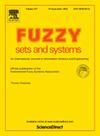Generalized fuzzy betweenness relations and their connection with fuzzy Čech closure spaces
IF 2.7
1区 数学
Q2 COMPUTER SCIENCE, THEORY & METHODS
引用次数: 0
Abstract
By a fuzzy betweenness relation we mean that a fuzzy ternary relation satisfies symmetry, reflexivity, antisymmetry and transitivity. This paper investigates certain generalized fuzzy betweenness relations, with the aim of showing that they can provide a suitable framework to establish the connection with fuzzy Alexandrov topology via fuzzy Čech closure operators. To be more precise, we define fuzzy quasi-betweenness relations by dropping symmetry and antisymmetry of fuzzy betweenness relations. After capturing a feature of them as fuzzy neighborhood-like structures, we apply a categorical lens to the study of the relationship between fuzzy quasi-betweenness relations and total strong fuzzy Čech closure spaces. It turns out that there is a Galois correspondence between the category of fuzzy quasi-betweenness relations and that of total strong fuzzy Čech closure spaces. As a direct consequence, there is a Galois correspondence between the category of fuzzy quasi-betweenness relations and that of strong Alexandrov fuzzy topological spaces.
广义模糊间性关系及其与模糊Čech闭包空间的联系
模糊间性关系是指模糊三元关系满足对称、自反性、反对称性和传递性。本文研究了某些广义模糊间关系,目的是证明它们可以提供一个合适的框架,通过模糊Čech闭包算子来建立与模糊Alexandrov拓扑的联系。为了更精确地定义模糊准间关系,我们抛弃了模糊间关系的对称性和反对称性。在捕捉到它们作为模糊邻域结构的一个特征后,我们应用范畴透镜研究了模糊拟间关系与全强模糊Čech闭空间之间的关系。证明了模糊拟间关系的范畴与全强模糊Čech闭空间的范畴存在伽罗瓦对应关系。作为直接结果,模糊拟间关系的范畴与强Alexandrov模糊拓扑空间的范畴之间存在伽罗瓦对应关系。
本文章由计算机程序翻译,如有差异,请以英文原文为准。
求助全文
约1分钟内获得全文
求助全文
来源期刊

Fuzzy Sets and Systems
数学-计算机:理论方法
CiteScore
6.50
自引率
17.90%
发文量
321
审稿时长
6.1 months
期刊介绍:
Since its launching in 1978, the journal Fuzzy Sets and Systems has been devoted to the international advancement of the theory and application of fuzzy sets and systems. The theory of fuzzy sets now encompasses a well organized corpus of basic notions including (and not restricted to) aggregation operations, a generalized theory of relations, specific measures of information content, a calculus of fuzzy numbers. Fuzzy sets are also the cornerstone of a non-additive uncertainty theory, namely possibility theory, and of a versatile tool for both linguistic and numerical modeling: fuzzy rule-based systems. Numerous works now combine fuzzy concepts with other scientific disciplines as well as modern technologies.
In mathematics fuzzy sets have triggered new research topics in connection with category theory, topology, algebra, analysis. Fuzzy sets are also part of a recent trend in the study of generalized measures and integrals, and are combined with statistical methods. Furthermore, fuzzy sets have strong logical underpinnings in the tradition of many-valued logics.
 求助内容:
求助内容: 应助结果提醒方式:
应助结果提醒方式:


